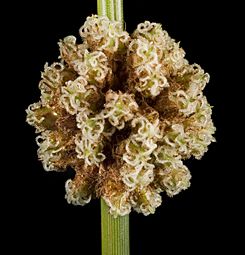Knotted club-rush facts for kids
Quick facts for kids Knotted club-rush |
|
|---|---|
 |
|
| Scientific classification | |
| Genus: |
Ficinia
|
| Species: |
nodosa
|
| Synonyms | |
|
|
The Ficinia nodosa, also known as the knotted club-rush or knobby club-rush, is a type of plant. It is a perennial plant, meaning it lives for many years. It grows from underground stems called rhizomes. This plant belongs to the Cyperaceae family, which is often called the sedge family.
Scientists believe this plant is native to Australia and New Zealand. It is found widely across the Southern Hemisphere, which includes southern parts of the world. The knotted club-rush can grow quite tall, from about 15 cm to 220 cm high. You can find it in sandy areas near the coast, close to lakes and the sea. In Australia, it grows in Western Australia, South Australia, Tasmania, Victoria, New South Wales, and Queensland.
About Its Name and Family
The Ficinia nodosa has had several names over time. One of its older names, and the very first one it was given, is Scirpus nodosus. The exact reason for its name is not fully known. However, there was some confusion about which plant group, or genus, Ficinia nodosa belonged to, even before the year 1980.
The original name, Scirpus nodosa, is usually credited to Christen Friis Rottbøll. He was a botanist from Denmark. In the year 2000, scientists used DNA studies to learn more about the plant. They looked at its genetic material. These studies showed that Ficinia nodosa has a woody rhizome (an underground stem). It also has a special part called a gynophore. These features proved that the plant should be moved into the Ficinia genus.



